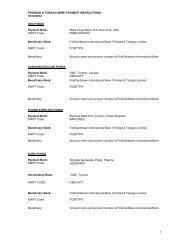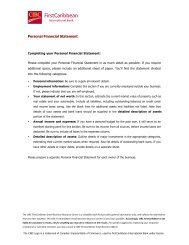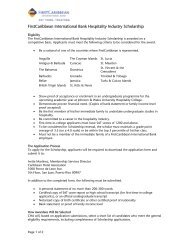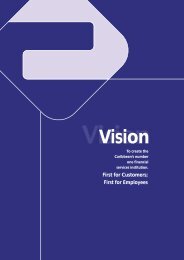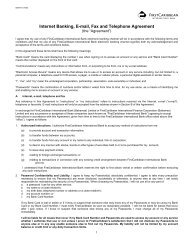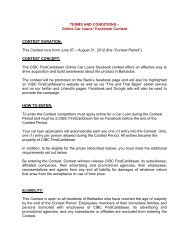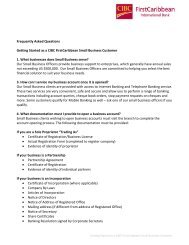(Jamaica) Limited - FirstCaribbean International Bank
(Jamaica) Limited - FirstCaribbean International Bank
(Jamaica) Limited - FirstCaribbean International Bank
You also want an ePaper? Increase the reach of your titles
YUMPU automatically turns print PDFs into web optimized ePapers that Google loves.
notes to the Financial Statements<br />
Year Ended 31 October 2009<br />
(Expressed in <strong>Jamaica</strong>n dollars unless otherwise indicated)<br />
2. Summary of Significant Accounting Policies (Continued)<br />
(r) Income taxes<br />
Taxation expense in the statement of income comprises current and deferred tax charges.<br />
Current tax charges are based on taxable income for the year, which differs from the income before tax reported<br />
because taxable income excludes items that are taxable or deductible in other years, and items that are never taxable<br />
or deductible. The Group’s liability for current tax is calculated at tax rates that have been enacted at the balance<br />
sheet date.<br />
Deferred tax is the tax that is expected to be paid or recovered on differences between the carrying amounts of assets<br />
and liabilities and the corresponding tax bases. Deferred income tax is provided in full, using the liability method, on<br />
temporary differences arising between the tax bases of assets and liabilities and their carrying amounts in the financial<br />
statements. Currently enacted tax rates are used in the determination of deferred income tax.<br />
Deferred tax assets are recognised to the extent that it is probable that future taxable income will be available against<br />
which the temporary differences can be utilised.<br />
Deferred tax is charged or credited in the statement of income, except where it relates to items charged or credited<br />
to stockholders’ equity, in which case deferred tax is also dealt with in stockholders’ equity.<br />
Deferred income tax liabilities are not recognised for the withholding tax and other taxes that would be payable on<br />
the unremitted earnings of the subsidiary as such amounts are permanently reinvested.<br />
(s) Retirement benefit obligations<br />
(i) Pension obligations<br />
The Group operates a defined benefit plan and a defined contribution plan, the assets of which are generally held<br />
in separate trustee-administered funds. The pension plans are generally funded by payments from the Group,<br />
taking account of the recommendations of independent qualified actuaries.<br />
A defined benefit plan is a pension plan that defines an amount of pension benefit to be provided, usually<br />
as a function of one or more factors such as age, years of service or compensation. The asset recognised in<br />
the balance sheet in respect of the defined benefit pension plan is the difference between the present value<br />
of the defined benefit obligation at the balance sheet date and the fair value of plan assets, together with<br />
adjustments for unrecognised actuarial gains and losses and past service cost. The defined benefit obligation is<br />
calculated annually by independent actuaries using the projected unit credit method. The present value of the<br />
defined benefit obligation is determined by the estimated future cash outflows using interest rates of government<br />
securities which have terms to maturity approximating the terms of the related liability. Actuarial gains and losses<br />
arising from experience adjustments and changes in actuarial assumptions are charged or credited to income<br />
over the expected average service lives of the related employees.<br />
Past service costs are recognised immediately in income, unless the changes to the pension plan are conditional<br />
on the employees remaining in service for a specified period of time (the vesting period), in which case, past<br />
service costs are amortised on a straight-line basis over the vesting period.<br />
A defined contribution plan is a pension plan under which the Group pays fixed contributions into a separate<br />
entity (a fund) and will have no legal or constructive obligations to pay further contributions if the fund does not<br />
hold sufficient assets to pay all employee benefits relating to employee service in the current and prior periods.<br />
The regular contributions constitute net periodic costs for the year in which they are due and as such are included<br />
in staff costs. The Group’s contributions to defined contribution pension plans are charged to the statement of<br />
income in the year to which they relate.<br />
36



